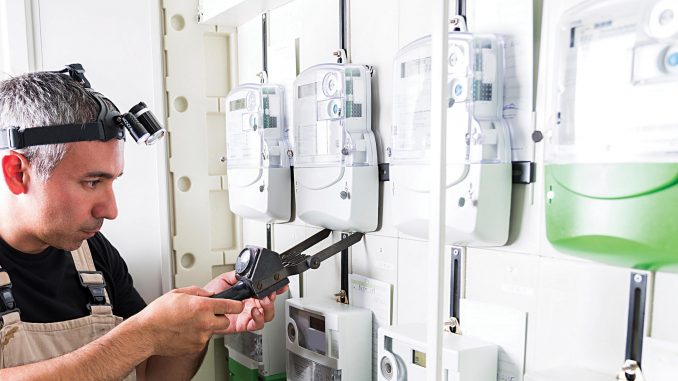
Meter testing is done to assess the quality of meters to ensure their reliability. Meeting the established technical and functional standards requires testing to be undertaken at various stages. As meters of different technologies and designs are in use, standardisation is of paramount importance to ensure uniformity, resolve interoperability issues and make the process of meter testing more streamlined. The Bureau of Indian Standards (BIS) has defined metering standards to help undertake a comprehensive assessment of meters. While some of the standards for conventional meters, including IS 13779 and IS 14697, have been in existence for almost 20 years now, those for smart meters (IS 16444) were established in 2015 and amended in 2017. Prior to this, different states were issuing different specifications for smart meters and it was difficult to test them on uniform technical requirements. There is a need to test the smart meters being installed for assessing their performance and ensuring compliance with the standards.
A look at the standards and testing methods for smart meters in India…
Standards for smart meters
In August 2015, BIS published the smart meter standard IS 16444, consisting of two parts. Part 1 covers the general requirements and tests for AC static direct connected watt-hour smart meters (Classes 1 and 2), while Part 2 covers AC static transformer operated watt-hour and VaR-hour smart meters (classes 0.2S, 0.5S and 1.0S). IS 16444 covers single-phase energy meters and three-phase energy meters (with and without net metering facility).
In March 2016, another standard, IS 15959: Data exchange for electricity meter reading, tariff and load control – Companion Specification for Smart Meters, was revised and published as IS 15959: Part 2 Smart Meter. This standard specifies the protocol and communication testing requirements and is applicable to smart meters designed as per IS 16444. Further, the functional requirements and technical specifications of smart meters as well as advanced metering infrastructure (AMI) have been laid down by the Central Electricity Authority (CEA). The technical requirements developed by any utility must adhere to BIS standards and CEA specifications.
Types of meter tests
As per Indian standards, smart meters must be subject to metrology tests, load switch capability tests and device language message specification protocol verification.
Metrology test
The basic metrology testing requirements for smart meters are largely the same as those for single- or three-phase whole current meters (including prepaid meters) as specified in IS 13779 and IS 15884. Metrology testing consists of several tests to assess the insulation properties, accuracy, effects of influence quantities, electromagnetic compatibility, climatic influences and other electrical and mechanical requirements. The tests of insulation properties pertain to impulse voltage tests, AC high voltage tests and insulation resistance tests. The accuracy requirement tests check for ambient temperature influence, limits on error, no-load condition, starting condition, meter constant, etc. The test of influence quantities has requirements of harmonic components, reverse phase sequence, voltage variation and frequency variation. The tests of electrical requirements include tests for power consumption, short-time overcurrents, influence of self-heating and test of influence of immunity to earth/phase fault. The test for electromagnetic compatibility assesses surge immunity, electrostatic discharge, fast transient burst and radio interference, among others. The testing for mechanical requirements includes vibration tests and shock tests. Lastly, there are tests for climatic influences that assess the impact of the ambient weather and include dry heat tests, cold tests and damp heat cyclic tests.
Test of load switch
The basic difference between conventional energy meters and a smart meters is that in the latter the performance data can be accessed from a remote location and smart meters have a connect/disconnect functionality. The test for switch load assesses the performance of the load switch used for remote connect/disconnect. Load switch tests need to be conducted as per the user category. For Utilisation Category 1 (UC 1), only one test needs to be conducted, wherein the load switch will be designed and rated to make and break at Vref, Imax with linear resistive load and at Vref, Imax, 0.4 inductive power factor for 3,000 operation. For Utilisation Categories 2 and 3 (UC 2 and UC 3), eight tests need to be conducted in a specific order: load switching capabilities, normal operation, electrical endurance, line to load voltage surge withstand, fault current-making capacity, short-circuit current-carrying capacity, minimum switch current, and dielectric strength.
Test of DLMS protocol verification
The DLMS protocol verification is the last stage of meter testing. The data exchange protocol chosen for smart meters would be as per IS 15959 Part 1 and Part 2. The purpose of this test is to ensure that the protocol is implemented in the meter and data from various object identification systems (OBIS). The Conformance Test Tool 3.1 (extended) and Meter Explorer are used for the purpose of protocol verification.
The way forward
A significant advancement in the digitalisation of grid systems has been the shift from conventional meters to smart meters. Going ahead, smart meter technology will be at the forefront of enhancing the functioning of the grid system. While smart meters today provide a lot of data pertaining to power consumption, with further advancements in technology, they will also be able to directly measure total harmonic distortion (THD). At present, the DLMS protocol standard IS 15959 does not address the power quality/THD parameter in the OBIS list. Hence, the THD parameter must be defined for OBIS. Another change that needs to be brought about is with regard to the metrological parameter, where the effect of harmonics on reactive power is not related to the functionality. Efforts in this regard will help discoms perform better analysis.
With increasing digitalisation, accuracy in meter reading has become necessary as it determines the revenue of the discom by the source of the bill paid by consumers. Thus, it should be ensured that there are no significant deviations in the consumption and maximum demand readings. In such a scenario, the testing process plays an important role in determining the reliability of energy meters. This will be beneficial to both manufacturers and utilities as the observations and the results derived from testing will help them understand the reliability and quality of the product.
Further, each test, at every stage, has its significance because during “type test”, failure in any one test results in non-compliance with the requirement of standards. Further, with the growing adoption of smart meters across states, the number of meter testing laboratories needs to be increased. More reliable, state-of-the-art facilities are required to cater to the growing test requirements.
To conclude, the installation of good quality meters is essential for the health of the distribution segment. To this end, the standardisation of tender documents, expansion of meter testing laboratories, and research and development for improving meter design and testing capability would go a long way in improving metering infrastructure.
With inputs from a presentation by Electrical Research and Development Association



